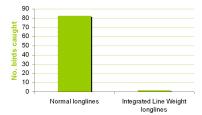
Simple and inexpensive measures exist which can dramatically reduce the number of seabirds killed by longline and trawl fisheries each year.

Thousands of seabirds—particularly albatrosses—are killed every year in longline fisheries when they attempt to snatch baited hooks being set behind the boats. Birds are caught on the hooks, dragged underwater and drowned. Birds can also be killed in trawl fisheries when they become entangled in cables and nets. This has led to severe long-term population declines in several albatross species. Seventeen of the 22 species of albatross are classified as globally threatened, with the remainder Near Threatened, and fisheries are the major threat to many of these species (BirdLife International 2008).
The good news—for albatrosses, fishermen and conservationists alike—is that simple measures can reduce the bycatch of seabirds without any negative effect on fish catches. Indeed, fish catches actually increase in some cases, as shown by a trial of mitigation measures on a Norwegian longline fishing vessel. With the use of a ‘bird-scaring line’, for instance, bird bycatch dropped to zero, while fish catch increased by over 30% (see figure a) (Løkkeborg 2001). More fish can be caught because fewer baits are lost to birds; birds can steal up to 18 baits before themselves being caught. A recent study in a small fishery (3 vessels) in Argentina demonstrated that ‘bird-scaring lines’, which reduce bait loss to scavenging birds, can lead to savings of between $1-2 million over a ten year period (Gandini and Frere 2010).

Other simple and effective measures include setting longlines at night when birds are less active, and adding weights to lines to make them sink more rapidly out of reach of seabirds (Figure b). These measures can reduce seabird bycatch by up to 80–90%, especially when used in combination. BirdLife has worked closely with Fishtek (UK) to develop new mitigation measures for pelagic longline fisheries, including a line weighting system that greatly improves crew safety and a hook ‘pod’ that covers the point and barb of the baited hook and only opens once at a depth of 10m.
Although this message seems simple enough, the challenge is to communicate it effectively to the diverse communities of fishermen worldwide Furthermore, what works for one fishery does not necessarily work for others. BirdLife’s Albatross Task Force is working with fishermen in key seabird bycatch ‘hotspots’ in South America and southern Africa to identify and demonstrate the best ways to reduce seabird bycatch, to convince fishermen of the economic and conservation benefits of mitigation measures, and to work torwards regulatory support for best practice mitigation.
Related Case Studies in other sections
References
Compiled: 2004 Last updated: 2012
Recommended Citation:
BirdLife International (2012)
Simple changes to fishing methods can get seabirds off the hook .
Downloaded from https://datazone.birdlife.org/sowb/casestudy/simple-changes-to-fishing-methods-can-get-seabirds-off-the-hook- on 22/12/2024